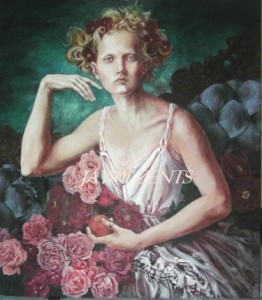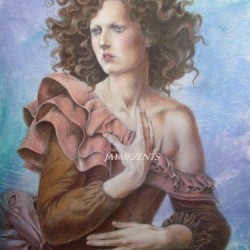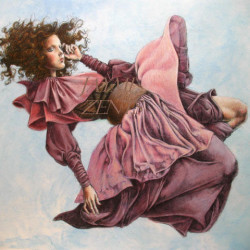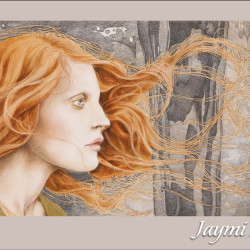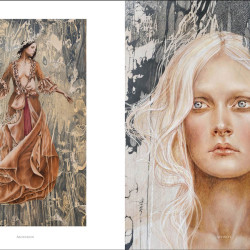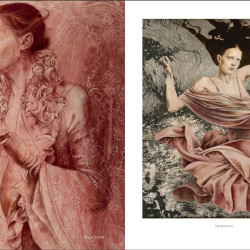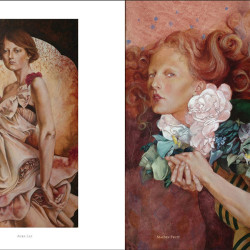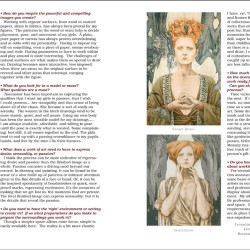Q: How do you inspire the powerful and compelling images you create?
A: Working with organic surfaces, from wood to stained papers, skins to fabrics, has always been pivotal for my figures. The patterns in the wood or stain help to decide placement, pose, and movement of my girls. A plain, pure paper or canvas has always proven overwhelming and at odds with my personality. Having to impose my will on something, even a piece of paper seems overbearing and rude. Having parameters to have to work within and play around is more interesting. The challenges of natural surfaces are what makes them so special to draw on. Drawing becomes more interactive, less imposed when there are areas on the original surface to be revered and other areas that interrupt, merging together with the figure.
Q: What do you look for in a model or muse? What qualities are a must?
A: ‘Ascension’ has been important in capturing the qualities that I want my girls to possess, that I wish I could possess…her tranquility and that sense of being above all of the chaos. She became a sort of study on serenity. The women in the birch drawings tend to be more stately, quiet, and self-aware. Using my own body has been the most sensible model for my drawings…..I am always available, affordable, and willing to pose until the pose is exactly what is wanted. Some complaining, but still, it all comes together in the end. The girls tend to end up with a passing resemblance to my pupils, hands, and feet by the time I fix their features.
Q: What does a work of art need to have to express desire, sensuality, or passion?
A: I think the process can be more indicative of expressing desire and passion than the finished image as a whole. Passion connotes a driving need beyond our control. In drawing and painting, it can be found in the sense of a slow build-up of patterns or intimate attention given to the fine details of a face or hand. Or, it can be the inspired spontaneity of brushstrokes or quick, sure pencil marks, expressing excitement. It’s the moments of making that we get lost in, the moments that are private. The total finished image can express sensuality, but it is the details that reveal the passion.
Q: Do you need to have the right environment or setting to create in? If so what preparations do you make to prepare the surroundings you work in?
A: Though a simpler space allows more focus, simple is rarely available here. The reality is a bit more chaotic. I have, err, “baroque” taste. Carved furniture and frames full of animals and nature, lots of collections of “fancies” and organic treasures that other people just consider compost but that I cherish(nests, skeletons, tiny mummies from our yard). Seemingly every doll, super ball, troll, and rock collection from childhood still lives with me. As long as there is a 5 x 7 foot area to sit on the floor and draw, I can deal with a full environment of curiosities. Once drawing begins, and I get caught up in the details, the surroundings are less influential.
Q: How much time would you say you spend on the average to get a painting or body of work ready for a gallery exhibition? Can you share your experience with this process?
A: Time varies so much from one drawing to the next. If there is a deadline, I make time work, no matter what. But generally, I see time as a somewhat arbitrary measure in art. Some drawings work from the very first mark and time disappears so quickly, getting lost in the details and excitement. Others can be a struggle, with lots of erasing, sanding, second-guessing, and cursing consuming time and energy. Drawing is like gardening for me, where an entire day passes, before even realizing I forgot to eat. Mommy has always told me that when you lose track of time, it is a sign of what each person’s gift is in life.
Q: Do you have any advice for our readers about working with galleries?
A: For several years, I have been the installation assistant at a gallery, giving witness to some basic observations. The most talented artists in our area are the most courteous and professional, while the less talented can display absolute lunacy of ego and entitlement. My advice is pretty basic. Be kind. Be professional, respecting the gallery’s time and space. Be respectful of the rules and requirements of each gallery. Usually, rules are in place from necessity thanks to previous experiences.



